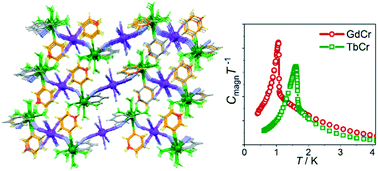当前位置:
X-MOL 学术
›
CrystEngComm
›
论文详情
Our official English website, www.x-mol.net, welcomes your
feedback! (Note: you will need to create a separate account there.)
Antiferromagnetic exchange and long-range magnetic ordering in supramolecular networks constructed of hexacyanido-bridged LnIII(3-pyridone)–CrIII (Ln = Gd, Tb) chains†
CrystEngComm ( IF 2.6 ) Pub Date : 2018-01-10 00:00:00 , DOI: 10.1039/c7ce02077e Szymon Chorazy 1, 2, 3, 4 , Michał Rams 2, 4, 5, 6 , Maciej Wyczesany 1, 2, 3, 4 , Koji Nakabayashi 7, 8, 9, 10, 11 , Shin-ichi Ohkoshi 7, 8, 9, 10, 11 , Barbara Sieklucka 1, 2, 3, 4
CrystEngComm ( IF 2.6 ) Pub Date : 2018-01-10 00:00:00 , DOI: 10.1039/c7ce02077e Szymon Chorazy 1, 2, 3, 4 , Michał Rams 2, 4, 5, 6 , Maciej Wyczesany 1, 2, 3, 4 , Koji Nakabayashi 7, 8, 9, 10, 11 , Shin-ichi Ohkoshi 7, 8, 9, 10, 11 , Barbara Sieklucka 1, 2, 3, 4
Affiliation

|
The complexes of paramagnetic lanthanide(3+) ions (Gd3+,Tb3+) with 3-pyridone molecules combined in an aqueous solution with paramagnetic hexacyanidochromate(III) metalloligands led to the formation of two novel crystalline {[LnIII(3-pyridone)2(H2O)4][CrIII(CN)6]}·H2O (Ln = Gd, 1; Ln = Tb, 2) materials. They are composed of bimetallic Ln–Cr cyanido-bridged zig-zag chains which are further tightly connected by the rich system of hydrogen bonds involving terminal cyanides, water molecules and 3-pyridone ligands. Both 1 and 2 have a very weak yellowish colour as their strong absorption, related to the d–d transitions of the cyanide Cr(III) complex and 3-pyridone ligands, is moved to the UV range. 1 and 2 exhibit Ln–Cr antiferromagnetic exchange mediated within the coordination chains by molecular cyanide bridges. The magnetic susceptibility for the GdIII–CrIII 7/2–3/2 spin alternating chains of 1 was successfully analysed using quantum Monte Carlo simulations, giving a magnetic coupling constant, J, of −0.82 K. The additional interchain magnetic interactions ensured by the hydrogen bonding network result in the low temperature phase transition to the magnetically ordered state. Magnetic heat capacity measurements showed that 1, which has isotropic Gd(III) spin centers, becomes a molecule-based magnet below 1.06 K, while 2, bearing the highly anisotropic Tb(III), shows a higher critical temperature of 1.61 K. Thus, we show and discuss the crucial role of the non-covalent interactions in the induction of magnetic ordering for low dimensional cyanido-bridged coordination systems, and the positive impact of magnetic anisotropy on the strengthening of magnetic interactions.
中文翻译:

由六氰基桥连的Ln III(3-吡啶酮)-Cr III(Ln = Gd,Tb)链构成的超分子网络中的反铁磁交换和远距离磁有序性†
顺磁性镧系元素(3d)离子(Gd 3+,Tb 3+)与3-吡啶酮分子在水溶液中与顺磁性六氰基铬酸盐(III)金属配体的络合物导致形成两个新的晶体{[Ln III(3 -吡啶酮)2(H 2 O)4 ] [Cr III(CN)6 ]}·H 2 O(Ln = Gd,1 ; Ln = Tb,2)材料。它们由双金属的Ln-Cr氰基桥接的之字形链组成,这些链进一步通过涉及末端氰化物,水分子和3-吡啶酮配体的丰富氢键系统紧密连接。两者1和2具有很弱的淡黄色,因为它们的强吸收与氰化物Cr(III)配合物和3-吡啶酮配体的d–d跃迁有关,已移至UV范围。1和2表现出Ln-Cr反铁磁交换是通过分子氰化物桥在配位链内介导的。使用量子蒙特卡洛模拟成功地分析了Gd III -Cr III 7 / 2–3 / 2自旋交替链1的磁化率,给出了磁耦合常数J,为-0.82K。通过氢键网络确保的其他链间磁相互作用导致低温相变至磁有序状态。磁热容量的测量结果表明1,它具有各向同性的Gd(III)自旋中心,变得低于1.06 K A分子基磁体,而2,轴承高度各向异性铽(III),示出了更高的临界1.61 K的温度。因此,我们显示并讨论了非共价相互作用在低维氰基桥联配位体系的磁有序诱导中的关键作用,以及磁各向异性对增强磁相互作用的积极影响。
更新日期:2018-01-10
中文翻译:

由六氰基桥连的Ln III(3-吡啶酮)-Cr III(Ln = Gd,Tb)链构成的超分子网络中的反铁磁交换和远距离磁有序性†
顺磁性镧系元素(3d)离子(Gd 3+,Tb 3+)与3-吡啶酮分子在水溶液中与顺磁性六氰基铬酸盐(III)金属配体的络合物导致形成两个新的晶体{[Ln III(3 -吡啶酮)2(H 2 O)4 ] [Cr III(CN)6 ]}·H 2 O(Ln = Gd,1 ; Ln = Tb,2)材料。它们由双金属的Ln-Cr氰基桥接的之字形链组成,这些链进一步通过涉及末端氰化物,水分子和3-吡啶酮配体的丰富氢键系统紧密连接。两者1和2具有很弱的淡黄色,因为它们的强吸收与氰化物Cr(III)配合物和3-吡啶酮配体的d–d跃迁有关,已移至UV范围。1和2表现出Ln-Cr反铁磁交换是通过分子氰化物桥在配位链内介导的。使用量子蒙特卡洛模拟成功地分析了Gd III -Cr III 7 / 2–3 / 2自旋交替链1的磁化率,给出了磁耦合常数J,为-0.82K。通过氢键网络确保的其他链间磁相互作用导致低温相变至磁有序状态。磁热容量的测量结果表明1,它具有各向同性的Gd(III)自旋中心,变得低于1.06 K A分子基磁体,而2,轴承高度各向异性铽(III),示出了更高的临界1.61 K的温度。因此,我们显示并讨论了非共价相互作用在低维氰基桥联配位体系的磁有序诱导中的关键作用,以及磁各向异性对增强磁相互作用的积极影响。











































 京公网安备 11010802027423号
京公网安备 11010802027423号